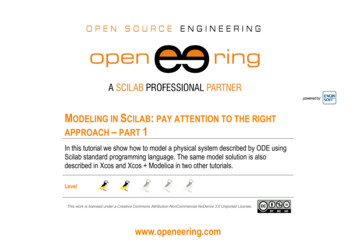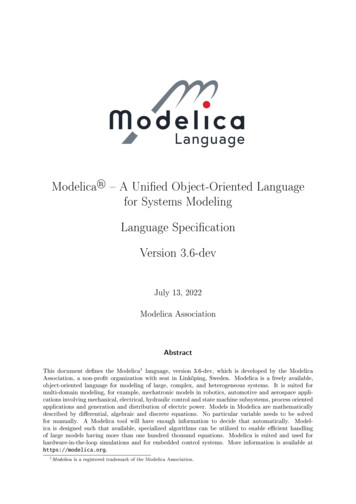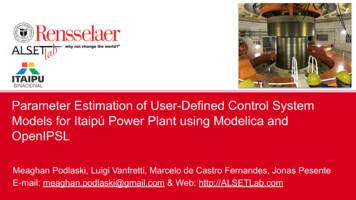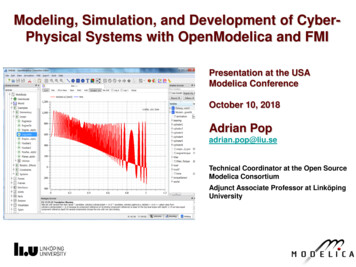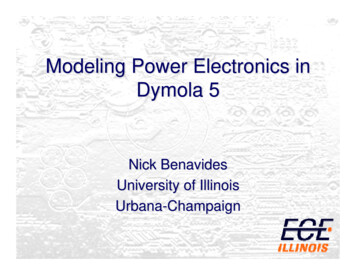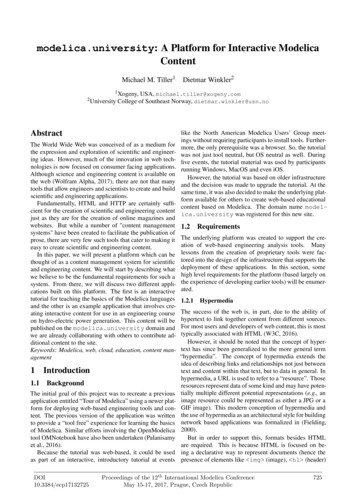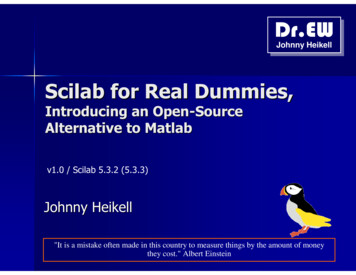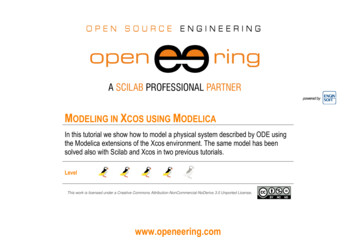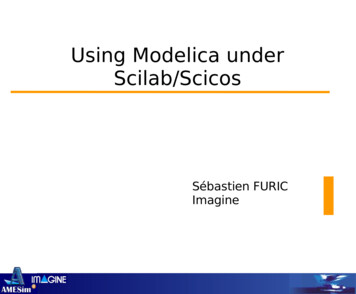
Transcription
Using Modelica underScilab/ScicosSébastien FURICImagine
Agenda Overview of the Modelica language–Basic concepts–Building models using ModelicaModelicac, a Modelica compiler–Overview–Generating C code from a Modelicaspecification using Modelicac
Overview of the ModelicalanguageBasic concepts
Structuring knowledge Modelica enables the creation of:–Structured �Packages
Basic language elements Basic types (Boolean, Integer, Realand String) Enumerations Compound classes Arrays Equations and/or algorithms Connections Functions
Data abstraction Packages, models, functions etc.are all described using classes–Classes are the only way to buildabstractions in Modelica–Classes enable structured modelling–Classes offer an elegant way ofclassifying manipulated entities thatshare common properties (nestedsets)
Example of a simple modelclass imppart circuitGroundGrnd;VsourceACVSrc(VA 220, f 50);ResistorR1(R 100);ResistorR2(R 10);InductorInd(L 0.1);CapacitorCapa(C 0.01);VoltageSensor Vsnsr;OutPutPortOut;equationconnect (Ind.n,VSrc.n);connect (Capa.n,VSrc.n);connect (Vsnsr.n,VSrc.n);connect (Capa.p,R2.n);connect (Vsnsr.p,R2.n);connect (R1.p,VSrc.p);connect (R2.p,VSrc.p);connect (Grnd.p,VSrc.p);connect (Ind.p,R1.n);Vsnsr.v Out.vi;end imppart circuit;
Example of a complicated model
Class description A class is composed of three kindsof sections:–Element declaration sections–Equation and/or algorithm clausesections–External function call sections
Restricted classes Restricted classes can be definedin Modelica by replacing thekeyword “class” by one thefollowing ones: “record”,“connector”, “model”, “block”,“type”, “package”, “function”Restricted classes allow librarydesigners to enforce the intendeduse of a given class
Element declaration section Elements include:–Local components and/or local classes(named elements)–Imports (to allow components andlocal classes of another class to be inscope)–“Extends clauses” (Modelica'sinheritance mechanism)
Visibility modifiers By default, a declared namedelement is public (i.e., it can beaccessed from the outside usingdot notation)Protected named elements can bedeclared using the prefix“protected”
Scoping rules Local classes declarations form anordered set of lexically enclosingparentsApart from its own namedelements, a class may only accessnames of constants and local classdefinitions in the enclosing set ofparentsBy default, name lookup is static
Static lookup of simple names Simple names (no dots) are lookupas follows:–In the sequence of control variablenames of enclosing “for” constructs–In the locally defined components andclasses (including inherited ones)–In the import statements (qualifiedones first, then unqualified ones)–In the sequence of enclosing parentsuntil the current class is encapsulated–In the unnamed toplevel class
Static lookup of compositenames Composite names (of the form A.B,A.B.C, etc.) are looked up asfollows:–A is looked up as any other simplename–B, C, etc. are looked up among thepublic declared named elements ofthe denoted element (includinginherited ones). If an element denotesa class, that class is temporarilyinstantiated and lookup is performedin the temporary instance
Static name lookup exampleclass Fooconstant Real pi 3.1416;Real x;Bar b;class BarReal y cos(2*pi*time);end Bar;class Bazconstant Real e 2.71828;end Baz;import Modelica.Math.*;equationBaz.e*x b.y;end Foo;
Dynamic lookup of names A named element declared withthe prefix “outer”references anelement of the enclosing set ofinstances that has the same nameand is declared with the prefix“inner”
Dynamic name lookup exampleclass BarTypeReal y;end BarType;class Fooinner Real pi 3.1416;inner class BarReal y;end Bar;Baz b;end Foo;class Bazouter Real pi;outer class Bar BarType;Bar b;equationModelica.Math.cos(2*pi*time) b.yend Baz;
Order of declarations The order of declaration ofelements does not matter (i.e., it ispossible to use a variable beforedeclaring it, provided a declarationexists in the scope)–Modelica was designed with ease ofcode generation in mind (a graphicaltool is not supposed to sort elementsbefore generating code)
Component declarationspecification A component declaration iscomposed of:–An optional type prefix–A type specifier–An optional array dimensionspecification–An identifier–An optional set of modifications–An optional comment
Examples of componentdeclarations To declare a constant:constant Real pi 3.141592654; To declare an array of 10 Resistors,each internal R 100 Ohms:Resistor[10] Rs ”my array of resistors”;Resistor Rs[10]; To declare an input vector of flowReal (i.e., floating point) numbers:flow input Real[:] Is;
Type prefix Three kinds of type prefixes:–“flow” prefix (indicating a flowvariable when set and a potentialvariable otherwise)–Variability prefix (one of “constant”,“parameter” or “discrete” in the caseof a non-continuous variable)–Causality prefix (“input” or “output”,to force causality, for instance in caseof a function formal parameter)
Component modifications Two kinds of modifications:–Value modifications (mainly used togive values to parameters)–Structural (type) modifications (usedto refine an existing class definition,either by restricting a type or byreplacing some named elements)
Initial values of variables Variables of predefined types canbe given initial values usingmodifications:Real x(start 0.0); /* just a guess */Real x(start 0.0, fixed true); /* we wantx to start at 0.0 */ Another way to initialize variablesis to use “initial equations”
Class inheritance Introduced by the “extends”keywordInheritance is used to:–Create new classes by extendingseveral existing ones (i.e., mergingcontents of several classes) beforeeventually adding new sections–Modifying an existing class usingclass modifications
Class inheritance exampleclass BarReal x 1;end Bar;class BazReal y;end Baz;class Fooextends Bar;Real z 3;extends Baz(y 2);end Foo;Foo my foo;/* my foo has 3 internal variables: x, y and zwhose values are 1, 2 and 3 respectively*/
Replaceable elements Named elements may be declaredas “replaceable”:–These elements may be replaced bynew ones in structural modifications,provided type compatibilityconstraints to be verified–Allow a flexible model parametrization(parametric polymorphism)
Example of element replacementclass ElectricalMotorreplaceable IdealResistor R(R 100);.end ElectricalMotor;class CircuitElectricalMotor m(redeclare MyResistorModel R);.end Circuit;
Partial classes Some classes are said to be“partial” if they are declared underthe heading “partial”A partial class can not beinstantiatedPartial classes are used to providea framework to develop modelsaccording to a given interface
Example of a partial classpartial class TwoPinPin p, n;Real v, i;equationi p.i;i n.i;v p.v n.v;end TwoPin;class Resistorextends TwoPin;parameter Real R;equationv R * i;end Resistor;
Equation clauses Equation clauses are used todescribe the set of constraints thatapply to a modelConstraints can apply either atinitialization time (initial equations)or at simulation time (ordinaryequations)
Examples of equation clausesclass Resistorparameter Real R;Pin p, n;Real i;Real v;equationp.v – n.v v;p.i i;n.i p.i;v R * i;end Resistor;class CircuitResistor R(R 100);VsourceAC Src;.initial equationSrc.v 0;equationconnect(R.p, Src.p);.end Circuit;
Comments about equationclauses Equation clauses are notsequences of statements! (inparticular, there is no notion ofassignment, nor evaluation order)It is however possible to describehow to compute a result by meansof sequences of assignments,loops, etc. in Modelica, but notusing equations!
Different kinds of equations (1) Equality between two expressions:v R * i; Conditional equation:if mode Modes.basic thenx basicControl.c;elsex complexControl.c;end if; “For” equation:for k in 1 : n loopv[k] R[k] * i[k];end for;
Different kinds of equations (2) “Connect” equation:connect(R.p, Src.p); “When” equation:when x 0.0 thenreinit(a, a);reinit(v, 0);end when; “Function call”:assert(n 0, “Model is not valid”);
Expressions Modelica provides the necessaryfunctionalities to express:–The usual “mathematical” functions(sin(), cos(), exp(), etc.)–The derivative of a variable–Conditional expressions–“Event-free” expressions–Multi-dimensional arrays andassociated operations
Variability of expresions Varibility modifiers in �“discrete”Discrete variables and ordinaryvariables only may change theirvalues during simulation time(discrete variables are onlymodified inside “when” equations)
Examples of equations Algebraic equation:v R * i;i v / R; // a “less general” formulation Differential equation:a g;der(v) a;der(x) v; // der(der(x)) a is illegal! Conditional expression in equation:y if x x0 then exp(x0) else exp(x);y if noEvent(x x0) then exp(x0) elseexp(x); // the correct version
Algorithm clauses Algorithm clauses are sequences ofassignments and control structuresstatementsAlgorithm clauses are used todescribe how a quantity has to becomputedLike equation clauses, algorithmclauses may apply either atinitialization time or at simulationtime
Different kinds of statements(1) Assignment:y : 2 * x; “If” statement:if x 0.0 theny : x;elsey : x;end if; “For” statement:for i in 1 : n loopy[i] : 2 * x[i];end for;
Different kinds of statements(2) “While” statement:while abs(x – y) eps loopx : y;y : x – f(x) / fdot(x);end while; “When” statement:when x 0.0 theny : 0;end when; Continuation statements:return;break;
Examples of an algorithm clauseblock Fibinput Integer n;protected Integer p, q: 1;public output Integer f: 1;algorithmassert(n 0, “Argument must be strictly positive”);for i in 1 : n loopf : p q;p : q;q : f;end for;end Fib;
External function calls Modelica allows the user to callexternal functions written in aforeign language (only C andFORTRAN are currently supported)Modelica provides the necessaryframework to handle formalparameters and multiple returnvalues
Restrictions over externalfunctions External functions must be “pure”,in the sense that they should notattempt to alter any variable thatis not declared as “output” in thecalling Modelica codeAlso, external functions mustreturn the same values given thesame arguments (referentialtransparency property)
Exemple of external functionfunction Fooinput Real x[:];input Real y[size(x,1),:];input Integer i;output Real u1[size(y,1)];output Integer u2[size(y,2)];external "FORTRAN 77"myfoo(x, y, size(x,1), size(y,2), u1, i, u2);end foo;
References Modelica's official WEB site:– http://www.modelica.orgBooks:–“Introduction to Physical Modelingwith Modelica”, by M. Tiller–“Principles of Object-OrientedModeling and Simulation withModelica 2.1”, by P. Fritzson
Overview of the ModelicalanguageBuilding models using Modelica
Notion of package A package is a hierarchical set ofModelica classes and constantcomponentsPackages may be stored:–As nested modelica classes, in asingle file–In the host file system, as a tree ofdirectories and files
Contents of a package Packages are generally divided intosubpackages corresponding to adiscipline (library)The default Modelica packagecontains the definition of:–physical quantities and constants–Useful connectors, blocks and models(electrical domain, mechanicaldomain, etc.)–Many more.
Overview of a Modelica library A library usually provides severalsubpackages containing:–The public types used in the library–Eventually, some useful functions–The connectors used to build classes–Interfaces of classes–Instantiable classes–Some test models
Example of a Modelica librarypackage MyElectricalLibrarypackage Typestype Voltage Real(unit ”v”);type Current flow Real(unit ”A”);end Types;package Connectorsconnector PinVoltage v;Current i;end Pin;end Connectors;package Interfacespartial model TwoPin.end TwoPin;.end Interfaces;.end MyElectricalLibrary;
Building models To build models, one has toproceed the following steps:–Define the types attached to thediscipline–Define connectors–Build library models–Build “main” models (i.e., models thatcan be simulated)
Model building exampletype Voltage Real(unit ”v”);type Current flow Real(unit ”A”);connector PinVoltage v;Current i;end Pin;model Resistor . end Resistor;model Capacitor . end Capacitor;.model CircuitResistor R1(R 100);Capacitor C1(C 0.001);.equationconnect(R1.p, C1.n);.end Circuit;
Modelicac, a Modelica compilerOverview
History 1998 2001: SimLab project (EDFR&D and TNI)–Causality analysis problem–Symbolic manipulation ofmathematical expressions2001 2004: SimPA Project (TNI,INRIA, EDF, IFP and Cril Technology)–Compilation of Modelica models–Automatic event handling, DAE solvers–Ehancements of Scicos's editor
Inside Modelicac Modelicac is composed of threemain modules:–Modelica parsing and compilation–Symbolic manipulation–Code generation
Compilation modes Modelicac can be used for twodifferent purposes:–Compiling connectors and librarymodels as “object files”–Generating code (usually C code) forthe target simulation environment(for instance, Scicos)
The compiled modelica subset:class definitions Only two kinds of classes arecurrently supported–“class”: to describe connectors andmodels–“function”: to describe externalfunctions“encapsulated”, “final” and“partial” are not supported
The compiled modelica subset:definition of elements An element can be either aninstance of another class or aninstance of the primitive type“Real”Only “value” modifications aresupportedLocal classes, imports andextensions are not currentlysupported
The compiled modelica subset:equations and algorithms Initial equations are not supported(use modifications instead)Equations defined by equality,“for” equations and “when”equations are supportedCurrently, it is possible to useneither “if” equations noralgorithm clauses
The compiled modelica subset:external functions Only “Real” scalars can currentlybe passed as arguments tofunctionsFunctions only return one “Real”scalar resultThe foreign language is supposedto be C
Model transformation Before generating code for thetarget, Modelicac performs thefollowing tasks:–Building an internal flat modelrepresenting the model to simulate–Performing some symbolicsimplifications (elimation of thelinearities, inversions of somebijective functions)–Eventually, computing the analyticjacobian matrix of the system
Modelica library files Modelicac requires a file to containexactly one Modelica classdefinitionThe name of the file is the same asthe name of the defined class,followed by the suffix “.mo”
Compiling library models Modelicac has to be invoked withthe “-c” option:– Modelicac -c model.mo Modelicac generates a file named“ model .moc” that containsbinary object codeNo link is done at that stage,names of external classes are onlylooked up when flattening acomplete model
Writing a “main” model The difference between a “main”model and a library model is that“main” models are required to bewell constrainedUsually, writing main models is notdone by the user: graphicalsimulation environments (likeScicos) can do it automatically
Compiling a “main” model By default, Modelicac considers thefile passed as argument to containa “main” model:modelicac model.mo Additional command linearguments can be passed toModelicac, for instance:–-o filename : to indicate the nameof the file to be generated–-L library path : to indicate whereto find object files to link to the model
The C code generated byModelicac for the Scicos target Modelicac generates a filecontaining a C function that iscompiled and linked against Scilabbefore simulation takes placeThe generated C code is in fact thecode of an ordinary external Scicosblock
Compilation processLibrary model filesObject code files*.mo*.mocmodelicac -c model.mo “Main” model file*.moTarget code file*.cmodelicac -o filename model.mo -L librarypath
Modelicac, a Modelica compilerGenerating C code from aModelica specification usingModelicac
Building an electrical library(1) Defining connectorsclass PinReal v;flow Real i;end Pin;
Building an electrical library(2) Defining a class of resistorsclass ResistorPin p, n;Real v, i;parameter Real R “Resistance”;equationv p.v – n.v;i p.i;i n.i;v R * i;end Resistor;
Building an electrical library(3) Defining a class of capacitorsclass CapacitorPin p, n;Real v;parameter Real C “Capacitance”;equationv p.v – n.v;0 p.i n.i;C * der(v) p.i;end Capacitor;
Building an electrical library(4) Defining a class of inductorsclass InductorPin p, n;Real i;parameter Real L “Inductance”;equationL * der(i) p.v – n.v;0 p.i n.i;i p.i;end Inductor;
Building an electrical library(5) Defining a class of AC voltagesourcesclass VsourceACPin p, n;parameter Real VA 220 "Amplitude";parameter Real f 50 f*time) p.v – n.v;0 p.i n.i;end VsourceAC;
Building an electrical library(6) Defining a class for the groundclass GroundPin p;equationp.v 0;end Ground;
Writing a “main” modelclass CircuitResistor R1(R 100), R2(R 10);Capacitor C(C 0.01);Inductor I(L 0.1);VsourceAC S(V0 220.0, f 50);Ground G;output Real v;equationconnect(R1.p, S.p);connect(R1.n, I.p);connect(I.n, S.n);connect(R2.p, S.p);connect(R2.n, C.p);connect(C.n, S.n);connect(G.p, S.p);v C.p.v C.n.v;end Circuit;
Invoking Modelicac (1) Compiling the library models isdone by entering the followingcommands:modelicac -c Pin.momodelicac -c VsourceAC.momodelicac -c Ground.momodelicac -c Resistor.momodelicac -c Capacitor.momodelicac -c Inductor.mo
Invoking Modelicac (2) Finaly, to compile the “main”model, enter:modelicac -o Circuit.c Circuit.mo
Writing an external function(1) The prototype of the externalfunction is an ordinary C “headerfile”:#include math.h float Sine(float);
Writing an external function(2) The C code of the externalfunction:#include “Sine.h”float Sine(float u){float y;y sin(u);return y;}
Writing an external function(3) The Modelica code of the externalfunction:function Sineinput Real u;output Real y;external;end Sine;
Compiling an external function External functions are compiledlike any ordinary library model:modelicac -c functionname.mo By default, Modelicac assumes a Cheader file (with the same basename) to be present in thecompilation directoryAdditional paths can be indicatedusing the “-hpath” option
Calling an external function froma Modelica model The VsourceAC model, rewritten tocall an external version of the sinefunction:class VsourceACPin p, n;Real v;parameter Real V0 "Amplitude";parameter Real f "Frequency";parameter Real phi "Phase angle";equationV0 * Sine(6.2832 * f * time phi) v;v p.v n.v;0 p.i n.i;end VsourceAC;
Generated C code.if (flag 0) {v0 sin(314.16*get scicos time());res[0] 0.01*xd[0] 0.1*x[0] 22.0*v0;res[1] 0.1*xd[1] 100.0*x[1] 220.0*v0;}.
Agenda Overview of the Modelica language - Basic concepts - Building models using Modelica Modelicac, a Modelica compiler - Overview - Generating C code from a Modelica specification using Modelicac
